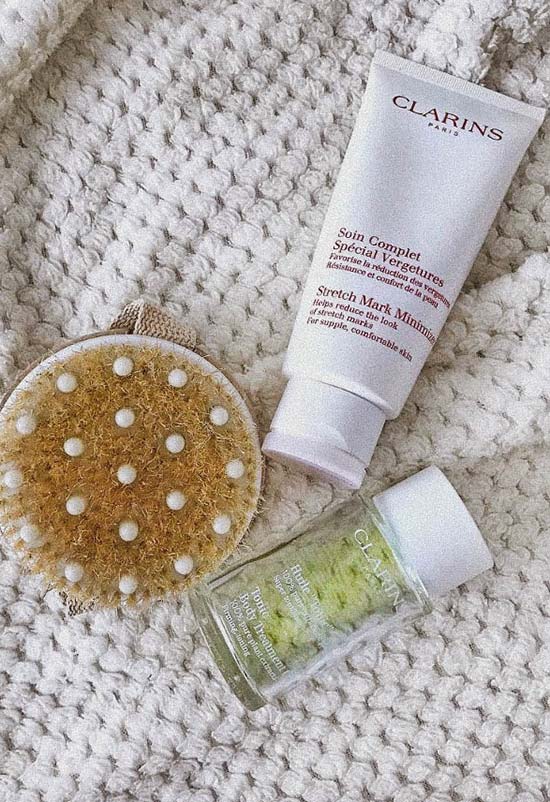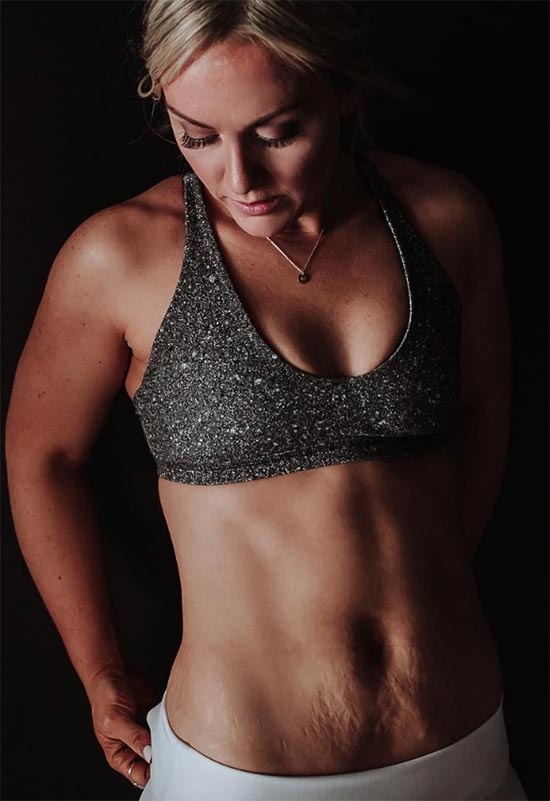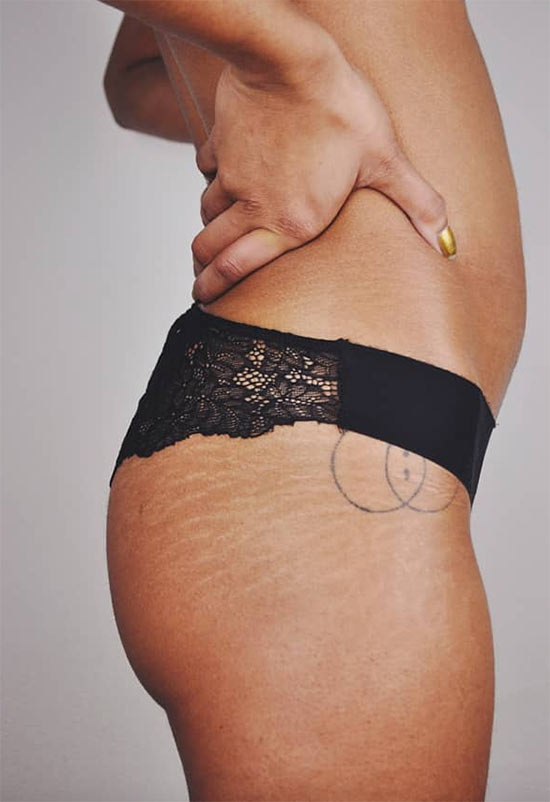Stretch mark removal is often the main cosmetic concern on women’s minds, especially after pregnancy. These marks are referred to in medical literature as striae, and they can show up on the body after the skin has been rapidly stretched for whatever reason. Since stretch marks occur in the central layer of skin rather than the top one, they are quite difficult to totally eliminate.
While I don’t mind the silvery tiger stripes I have on my thighs, I understand that many women will do anything to figure out how to remove stretch marks. Whether you’re interested in stretch mark removal or you couldn’t care less, I celebrate your choice! The important thing is that you feel comfortable and confident in your body.
In this article, I’ll explain exactly what stretch marks are and how they are formed, and list the main reasons why people might end up with them. I’ll give you the low-down on the best methods for stretch mark removal, along with some tips and tricks that will help you with stretch mark prevention.
In this article:
- What Are Stretch Marks?
- Types of Stretch Marks
- Symptoms & Causes of Stretch Mark
- How to Remove Stretch Marks
- How to Prevent Stretch Marks
What Are Stretch Marks?
Stretch marks, which are medically known as striae, are tears that show up in the dermis level of the skin. During times of high growth, which can include pregnancy, growth spurts, and weight gain, the skin stretches very rapidly and doesn’t have the chance to repair itself. This leads to tears that are visible even through the epidermis, the top layer of the skin.
Stretch marks usually show up on the belly, breasts, thighs, hips, buttock, shoulders, or arms, although they can take place on other parts of the body as well. The tears usually appear as long streaks or stripes, and they can be slightly red or purple, especially when newer, or light and silvery, especially once some time has passed and they have atrophied. Stretch mark removal is easier when the stripes are newer and still reddish.
The dermis is the level of our skin that holds everything together. It is thicker than the epidermis and consists of strong connective tissues made up of elastin, which maintains the skin’s flexibility, and collagen, which keeps the skin firm. These are the connective tissues that tear when the subcutaneous tissues below suddenly start growing, causing the skin to expand.
It is important to focus on the fact that stretch marks happen under our top, visible layer of skin. Unlike wrinkles or hyperpigmentation, which occur on the epidermis, stretch marks take place on a much deeper level, making them much harder to treat.
When the levels of the hormone cortisone are higher in the body, the dermis can have a difficult time producing collagen and elastin – the proteins that maintain the strength and elasticity of the skin. This makes stretch marks likelier to occur, as well.
This can impact people taking steroids or using corticosteroid creams. It can also impact people with syndromes or disorders that have an impact on the adrenal gland, which is the gland that produces cortisone in the body.
Types of Stretch Marks
Based on their color and formation, stretch marks usually are divided into two main groups:
- Striae Subrae: These are newly occurred pink or red stretch marks.
- Striae Albae: These are silvery white stretch marks, which are actually the same pink ones that have changed their color over time.
Other than the main types of stretch marks, there also exist the following categories:
- Striae Atrophicans: This type refers to thinned skin, which may develop because of Cushing’s syndrome, a surgical procedure or the use of corticosteroids.
- Striae Caerulea: These stretch marks have a bluish or purplish color and mostly develop in those with darker skin tones.
- Striae Gravidarum: This is the name for pregnancy stretch marks that appear on the abdomen, thigh or breast areas of women.
- Striae Nigrae: These are deep grey or black stretch marks that also develop on darker skin.
Symptoms & Causes of Stretch Mark
- Pregnancy: The rapid growth of the belly as the baby grows leads to stretch marks, usually along the sides of the lower abdomen. These are the stretch marks women tend to be most concerned about.
- Puberty: When we hit puberty, the body grows in all kinds of different ways. Boys and girls alike might experience stretch marks on the legs, arms, back, or shoulders as growth spurts lead to an increase in height. Girls are likely to experience stretch marks on the breasts or thighs, as those tend to increase in size during puberty.
- Weight Gain: All kinds of weight gain can lead to stretch marks, but it is only when the weight gain is rapid. Slow and moderate weight gain is less likely to lead to stretch marks, since it allows the skin to stretch slowly and gradually.
- Muscle Growth: Those who lift weights with the goal of growing their muscles will experience stretch marks due to the muscles growing rapidly under the skin. Weight lifters and body builders will often experience these stretch marks on their arms, legs, and back.
- Hormonal Syndromes: Diseases and disorders that impact the adrenal gland or lead to rapid skin growth, like Marfan syndrome, Ehlers-Danlos syndrome, or Cushing’s syndrome can all cause stretch marks.
- Breast Augmentation: Some people notice stretch marks on their breasts after having breast augmentation surgery, since the skin on the chest gets stretched to accommodate the fillers.
- Rapid Weight Loss: Stretch marks can suddenly show up after one has lost a lot of weight, although in reality chances are they existed beforehand and loss of weight just made them more visible.
- Steroids and Corticosteroid Creams: Cortisone is a hormone that can reduce the skin’s ability to produce collagen and elastin, so creams and steroids that increase its presence in the body can lead to increased stretch marks.

How to Remove Stretch Marks
Stretch mark removal is not an easy process. It’s certainly not as easy as slapping on some cream once or twice a day, despite what some skincare companies out there might tell you.
I’ve listed some of the best stretch mark creams out there in another article, some of which are better for prevention, while others can actually work for total fading when combined with a few other techniques. What do I mean by that? Let me go into details about all the things you can do for effective stretch mark removal!
Act Quickly
Stretch marks are easiest to treat when they are still fresh and new. Red or purple stretch marks might seem daunting, but they are actually easier to get rid of than their silvery-white counterparts.
Of course, stretch mark prevention is the easiest of all, so it is best to start treatments before the stretch marks have formed. Some treatments are not recommended for pregnant or breastfeeding women, so that is one thing to keep in mind.
Collagen-Rebuilding Topical Actives
That seems like a mouthful, doesn’t it? The active ingredients I’m talking about here are vitamin A, especially in the forms of retinol and tretinoin, vitamin C, and the various peptides that show up in skin care sometimes.
Of all of these ingredients, vitamin A makes for the very best stretch mark removal ingredient. It is also an exceptional stretch mark preventative, though it is not recommended for use during pregnancy.
Vitamin A is what I call a collagen rebuilder. This fascinating ingredient is capable of stimulating new collagen production in the skin and triggering regrowth. Topically, this is excellent for fine lines, acne, and texture issues, but on the dermal level this can mean the triggering of repair for stretch marks.
There is some evidence that vitamin A in the form of retinol can penetrate all the way down to that level all on its own, although the use of microneedling will definitely aid in penetration.
Vitamin C works similarly to retinol, but it is a little gentler, and it can be used as a preventative during pregnancy. The most effective (though also least stable) form of vitamin C in skin care is ascorbic, although it’s also excellent in its other forms, including magnesium ascorbyl phosphate and tetrahexyldecyl ascorbate.
Vitamin C aids in collagen synthesis, though it has other benefits such as brightening the skin and preventing premature aging.
Lastly, I want to talk about peptides, even though I consider them somewhat controversial. Peptides are a type of protein molecule with a very short chain. There is some evidence that when they penetrate the skin they can reach fairly deeply and repair and promote collagen well enough that the appearance of fine lines and wrinkles become diminished.
If this is true then it is possible that when paired with dermarolling, peptides can also trigger a reparative response for stretch marks. I wouldn’t recommend a product with peptides instead of retinol or vitamin C, but in conjunction with them it certainly can’t hurt.

Microneedling or Dermarolling
While these days dermarolling and microneedling are super popular for the face, they might actually be the best solutions for stretch mark removal on the body! Dermarolling, in particular, is easy to do at home, can be combined with other treatments, and it appears to have significant results. The only drawback? Dermarolling does require some maintenance, and it hurts a little bit.
Derma rollers are a type of handheld contraption with a spinning cylinder at the top. This spinning cylinder is covered in tiny needles that are just thin enough to easily puncture the skin without drawing blood.
When derma rollers are rolled over the skin, they puncture it, causing microtrauma. This microtrauma triggers a repair mechanism in the skin that leads to new collagen and elastin being formed. By forming these new proteins, stretch marks can start to heal, and over time their appearance can diminish very significantly.
The additional benefit of dermarolling is that it makes other skin ingredients extra effective. On their own, most stretch mark removal creams and serums simply do not penetrate deep enough to actually reach the stretch marks. However, if creams and serums (especially ones that contain vitamins A and C) are applied immediately after dermarolling, they can actually get deep enough to make a difference!
You do need to be careful when using derma rollers, however, as improper use can cause irritation, bruising, or even infection. To avoid infection, make sure to properly clean your derma rollers. After you’ve used a derma roller you want to make sure to sanitize it properly by letting it sit in a container filled with 99% alcohol for 10 minutes.
Use derma rollers once every 1-2 weeks (and even less frequently on the face), as using them more often will irritate and damage the skin, while using them less often will simply not give significant results.
A derma roller with a 1- or 2-mm needle length is perfect for reaching stretch marks. Make sure to cleanse your skin thoroughly first, apply a hydrating serum for cushioning, and follow up with skin-repairing creams or serums.
If you like the idea of dermarolling but are too nervous to do it by yourself at home, you might be interested to know that you can also get it done as a professional treatment by a licensed aesthetician.

Laser Treatments
Once we start looking at treatments that can be done at the doctor’s office or the spa, we’re also looking at a significant price jump for stretch mark removal. However, this is the best solution for those who would like rapid results and would rather avoid treating their stretch marks at home.
Much like with dermarolling, laser treatments also work by triggering the healing response of the skin with microtrauma. The laser operated by the aesthetician or doctor is a highly targeted and powerful ray of light that penetrates through the skin all the way down to the dermal level, where it triggers the same type of healing response a burn would, working to repair the stretch mark tears in the dermis.
It usually takes around 3 sessions of laser treatments to start seeing results, while total stretch mark removal will likely take even longer, depending on the person and the types of stretch marks. At around $500 a session, this can add up, although many spas and clinics offer package deals.
Make sure the salon or clinic you choose for your stretch mark removal treatments is clean and well-reviewed, and make sure you have good rapport with the clinician that will carry out the laser treatment.
Carboxytherapy
Carboxytherapy is a stretch mark treatment option that is less costly than laser, but seems to be extremely effective. While it is not as well researched as laser, early reviews are mostly positive, with many people seeing results from doing carboxytherapy. They often pair it with regular use of retinol creams and even dermarolling or microneedling.
Carboxytherapy is a treatment method in which a doctor or nurse injects the dermis with carbon dioxide, targeting stretch marks as well as cellulite. The CO2 works to stimulate the area where it was injected, improving blood flow and increasing collagen and elastin regeneration.
Most professionals recommend around 4 or 5 treatments for radical results, with treatments costing between $100 and $200 per session. Read reviews and decide for yourself whether you’d be interested in trying out this unique route for stretch mark treatment.
Time
I think that some of the stretch mark removal effects people assume come from stretch mark oils or creams actually come from the simple passing of time. Stretch marks will fade on their own over time, either until they are completely gone in the case of smaller stretch marks, or until they are just not very visible. Be patient and love yourself, because time heals all wounds.
How to Prevent Stretch Marks
It is significantly easier, not to mention cheaper, to try and prevent stretch marks than it is to get rid of them once they already exist. These are the steps you can take to keep your skin strong and to try and prevent those small tears in the dermis.
Keeping the Skin Moisturized
The regular application of topical body creams and oils are the first step to fortifying the skin and preventing stretch marks. While body oils and moisturizers do not penetrate past the epidermis, they do help to strengthen it and prevent its thinning, which may make it less likely to show any tears that happen below it.
There is some debate as to whether certain skincare ingredients that show up in moisturizers actually can penetrate past the epidermis and into the dermis. These ingredients include retinol, which I talk about more in the section on how to remove stretch marks, but they also include humectants with small molecules like certain types of hyaluronic acid.
Additionally, many stretch mark creams are formulated with emulsifiers that increase the ability of the product to penetrate into the skin – however, this still doesn’t necessarily mean that the product is penetrating past the epidermis.
When you read reviews of the various stretch mark removal creams, many people will proclaim that a product worked miraculously to prevent their stretch marks. It’s hard to gauge whether this is true or not, since the experiences are anecdotal, and also because there is no control. How can you tell if a stretch mark cream worked if its purpose was to stop something from happening?
With all this being said, there are a ton of benefits to keeping the epidermis moisturized, so I definitely recommend getting in the habit, especially during times like pregnancy or exercise when stretch marks are likelier to form.

Massage
It is possible that the real benefit of applying belly creams during pregnancy isn’t coming from the creams, but from the massage itself stimulating blood flow to the skin. A gentle massage can be easy to perform with any kind of stretch mark oil or moisturizer, so there is certainly no harm in it. Just be careful not to massage too aggressively, especially if you are treating a pregnant belly.
Treat the Stretch Marks Before They Show up
The same ingredients and practices that I recommend for stretch mark removal can also help prevent stretch mark formation in the first place. Chances are you will not want to use derma rollers or retinoids during pregnancy, but if you fear stretch marks due to other types of rapid skin stretching then definitely consider adopting some of the more intense stretch mark treatments.
Gain Weight Slowly
I can’t very well recommend that you don’t get pregnant or that you don’t gain weight, since things are not really all that simple. However, focusing on doing things slowly and moderately can certainly help prevent stretch marks.
Speak to your doctor about what a healthy way of increasing weight during pregnancy would look like, and if you are trying to put on weight, regardless of whether it’s muscle or fat, make sure you don’t gain it too rapidly.
Consume a Diet Rich in Vitamins and Minerals
A healthy diet is an important part of keeping all parts of the body functioning properly, including the dermis. It’s almost silly to recommend a healthy diet for stretch mark prevention, because a great diet has so many other benefits. If preventing stretch marks can motivate you to eat well, though, who am I to judge?
The nutrients that are most important when it comes to maintaining collagen production are vitamin C (which can come from fruits and veggies, and is also excellent when applied to the skin), vitamin A (orange veggies are your friends here, and once again, this vitamin is also super helpful when applied directly to the skin), foods and oils rich in Omega-6 and Omega-3 fatty acids, and zinc (plentiful in seafood, but can also be found in some grains).
If your diet is particularly prohibitive for whatever reason, or if you are simply a very picky eater, consider taking a multivitamin that is rich in all the nutrients I’ve listed. Prenatal vitamins are a great choice for pregnant women.
Photos via @__chybris, Instagram





